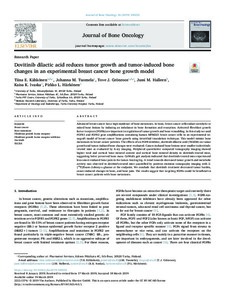Dovitinib dilactic acid reduces tumor growth and tumor-induced bone changes in an experimental breast cancer bone growth model
Tiina E. Kähkönen; Johanna M. Tuomela; Tove J. Grönroos; Jussi M. Halleen; Kaisa K. Ivaska; Pirkko L. Härkönen
https://urn.fi/URN:NBN:fi-fe2021042825824
Tiivistelmä
Advanced breast cancer has a high incidence of bone metastases. In bone, breast cancer cells induce osteolytic or mixed bone lesions by inducing an imbalance in bone formation and resorption. Activated fibroblast growth factor receptors (FGFRs) are important in regulation of tumor growth and bone remodeling. In this study we used FGFR1 and FGFR2 gene amplifications containing human MFM223 breast cancer cells in an experimental xenograft model of breast cancer bone growth using intratibial inoculation technique. This model mimics bone metastases in breast cancer patients. The effects of an FGFR inhibitor, dovitinib dilactic acid (TKI258) on tumor growth and tumor-induced bone changes were evaluated. Cancer-induced bone lesions were smaller in dovitinib-treated mice as evaluated by X-ray imaging. Peripheral quantitative computed tomography imaging showed higher total and cortical bone mineral content and cortical bone mineral density in dovitinib-treated mice, suggesting better preserved bone mass. CatWalk gait analysis indicated that dovitinib-treated mice experienced less cancer-induced bone pain in the tumor-bearing leg. A trend towards decreased tumor growth and metabolic activity was observed in dovitinib-treated mice quantified by positron emission tomography imaging with 2-[ 18 F]fluoro-2-deoxy-D-glucose at the endpoint. We conclude that dovitinib treatment decreased tumor burden, cancer-induced changes in bone, and bone pain. The results suggest that targeting FGFRs could be beneficial in breast cancer patients with bone metastases.
Kokoelmat
- Rinnakkaistallenteet [27094]
